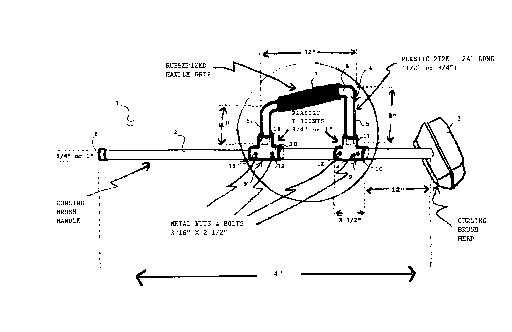Some of the information on this Web page has been provided by external sources. The Government of Canada is not responsible for the accuracy, reliability or currency of the information supplied by external sources. Users wishing to rely upon this information should consult directly with the source of the information. Content provided by external sources is not subject to official languages, privacy and accessibility requirements.
Any discrepancies in the text and image of the Claims and Abstract are due to differing posting times. Text of the Claims and Abstract are posted:
| (12) Patent: | (11) CA 2187238 |
|---|---|
| (54) English Title: | CURLING STABILIZER DEVICE |
| (54) French Title: | DISPOSITIF DE STABILISATION POUR LE JEU DE CURLING |
| Status: | Expired and beyond the Period of Reversal |
| (51) International Patent Classification (IPC): |
|
|---|---|
| (72) Inventors : |
|
| (73) Owners : |
|
| (71) Applicants : |
|
| (74) Agent: | |
| (74) Associate agent: | |
| (45) Issued: | 2000-12-26 |
| (22) Filed Date: | 1996-10-07 |
| (41) Open to Public Inspection: | 1998-04-07 |
| Examination requested: | 1999-10-14 |
| Availability of licence: | N/A |
| Dedicated to the Public: | N/A |
| (25) Language of filing: | English |
| Patent Cooperation Treaty (PCT): | No |
|---|
| (30) Application Priority Data: | None |
|---|
A curling stabilizer device for attachment to a curling brush handle has a framemember which includes a generally linear handle graspable by the hand of a curling
thrower and at least one structural member for spacing the handle from the curling brush
at a distance suitable for gripping by a sliding thrower. A releasable gripping device
encompasses the brush handle and fixedly attaches the frame member to the brush handle.
The frame member is oriented relative to the gripping device so that when the
gripping device is in gripping engagement with the brush handle, the linear handle
extends in line with the brush handle.
Dispositif stabilisateur de curling destiné à être fixé au manche d'un balai de curling, comprenant un bâti avec poignée généralement linéaire saisissable par la main d'un lanceur et au moins un élément de structure permettant d'espacer la poignée du balai à une distance appropriée pour la saisie par un lanceur glissant. Un dispositif de serrage entoure le manche du balai et attache l'élément de bâti au manche du balai. L'élément de bâti est orienté par rapport au dispositif de serrage de sorte que lorsque le dispositif de serrage est en contact étroit avec le manche du balai, la poignée linéaire se déploie en ligne avec le manche du balai.
Note: Claims are shown in the official language in which they were submitted.
Note: Descriptions are shown in the official language in which they were submitted.

2024-08-01:As part of the Next Generation Patents (NGP) transition, the Canadian Patents Database (CPD) now contains a more detailed Event History, which replicates the Event Log of our new back-office solution.
Please note that "Inactive:" events refers to events no longer in use in our new back-office solution.
For a clearer understanding of the status of the application/patent presented on this page, the site Disclaimer , as well as the definitions for Patent , Event History , Maintenance Fee and Payment History should be consulted.
| Description | Date |
|---|---|
| Time Limit for Reversal Expired | 2016-10-07 |
| Letter Sent | 2015-10-07 |
| Inactive: IPC deactivated | 2015-03-14 |
| Inactive: IPC from PCS | 2015-01-17 |
| Inactive: IPC expired | 2015-01-01 |
| Inactive: IPC removed | 2014-11-04 |
| Inactive: IPC removed | 2014-11-04 |
| Inactive: IPC removed | 2014-11-04 |
| Inactive: IPC removed | 2014-11-04 |
| Maintenance Request Received | 2014-09-03 |
| Maintenance Request Received | 2013-09-13 |
| Inactive: Office letter | 2002-09-10 |
| Inactive: Office letter | 2002-09-10 |
| Revocation of Agent Requirements Determined Compliant | 2002-09-10 |
| Grant by Issuance | 2000-12-26 |
| Inactive: Cover page published | 2000-12-25 |
| Pre-grant | 2000-09-07 |
| Inactive: Final fee received | 2000-09-07 |
| Letter Sent | 2000-08-24 |
| Notice of Allowance is Issued | 2000-08-24 |
| Notice of Allowance is Issued | 2000-08-24 |
| Inactive: Approved for allowance (AFA) | 2000-07-05 |
| Amendment Received - Voluntary Amendment | 2000-04-17 |
| Inactive: Office letter | 2000-01-31 |
| Inactive: S.30(2) Rules - Examiner requisition | 2000-01-31 |
| Inactive: Adhoc Request Documented | 2000-01-31 |
| Amendment Received - Voluntary Amendment | 1999-12-24 |
| Inactive: S.30(2) Rules - Examiner requisition | 1999-12-09 |
| Inactive: Status info is complete as of Log entry date | 1999-11-17 |
| Letter sent | 1999-11-17 |
| Advanced Examination Determined Compliant - paragraph 84(1)(a) of the Patent Rules | 1999-11-17 |
| Inactive: Application prosecuted on TS as of Log entry date | 1999-11-17 |
| All Requirements for Examination Determined Compliant | 1999-10-14 |
| Request for Examination Requirements Determined Compliant | 1999-10-14 |
| Inactive: Advanced examination (SO) fee processed | 1999-10-14 |
| Inactive: Cover page published | 1999-09-30 |
| Application Published (Open to Public Inspection) | 1998-04-07 |
| Small Entity Declaration Determined Compliant | 1996-10-07 |
There is no abandonment history.
The last payment was received on 2000-10-10
Note : If the full payment has not been received on or before the date indicated, a further fee may be required which may be one of the following
Please refer to the CIPO Patent Fees web page to see all current fee amounts.
Note: Records showing the ownership history in alphabetical order.
| Current Owners on Record |
|---|
| EARLE MORRIS |
| Past Owners on Record |
|---|
| None |